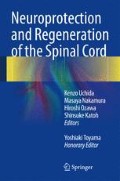Abstract
The objective of this study was to clarify the effects of a temporal blockade of IL-6/IL-6 receptor (IL-6R) engagement, using an anti-mouse IL-6R monoclonal antibody (MR16-1), on macrophage activation and the inflammatory response in the acute phase after spinal cord injury (SCI) in mice. MR16-1 antibodies versus isotype control antibodies or saline alone was administered immediately after thoracic SCI in mice. MR16-1-treated group samples showed increased neuronal regeneration and locomotor recovery compared with controls. Immunoblot analysis of the MR16-1-treated samples identified downregulation of Th1 and upregulation of Th2 cytokines. MR16-1 treatment promoted arginase-1-positive, CD206-positive M2 macrophages, with preferential localization of these cells at the injury site and enhanced positivity for Mac-2 and Mac-3, suggestive of increased phagocytic behavior. The results suggest that temporal blockade of IL-6 signaling after SCI abrogates damaging inflammatory activity and promotes functional recovery by promoting the formation of alternatively activated M2 macrophages.
Access this chapter
Tax calculation will be finalised at checkout
Purchases are for personal use only
References
Pineau I, Lacroix S et al (2007) Proinflammatory cytokine synthesis in the injured mouse spinal cord: multiphasic expression pattern and identification of the cell types involved. J Comp Neurol 500:267–285
Giger RJ, Hollis ER, Tuszynski MH et al (2010) Guidance molecules in axon regeneration. Cold Spring Harb Perspect Biol 2:a001867
David S, Bouchard C, Tsatas O et al (1990) Macrophages can modify the nonpermissive nature of the adult mammalian central nervous system. Neuron 5:463–469
Busch SA, Horn KP, Silver DJ et al (2009) Overcoming macrophage-mediated axonal dieback following CNS injury. J Neurosci 29:9967–9976
Gensel JC, Nakamura S, Guan Z et al (2009) Macrophages promote axon regeneration with concurrent neurotoxicity. J Neurosci 29:3956–3968
Mosser DM, Edwards JP (2008) Exploring the full spectrum of macrophage activation. Nat Rev Immunol 8:958–969
Gordon S (2003) Alternative activation of macrophages. Nat Rev Immunol 3:23–35
David S, Kroner A (2011) Repertoire of microglial and macrophage responses after spinal cord injury. Nat Rev Neurosci 12:388–399
Kigerl KA, Gensel JC, Ankeny DP et al (2009) Identification of two distinct macrophage subsets with divergent effects causing either neurotoxicity or regeneration in the injured mouse spinal cord. J Neurosci 29:13435–13444
Gruol DL, Nelson TE (1997) Physiological and pathological roles of interleukin-6 in the central nervous system. Mol Neurobiol 15:307–339
Van Wagoner NJ, Benveniste EN (1999) Interleukin-6 expression and regulation in astrocytes. J Neuroimmunol 100:124–139
Cafferty WB, Gardiner NJ, Das P et al (2004) Conditioning injury-induced spinal axon regeneration fails in interleukin-6 knock-out mice. J Neurosci 24:4432–4443
Okazaki M, Yamada Y, Nishimoto N et al (2002) Characterization of anti-mouse interleukin-6 receptor antibody. Immunol Lett 84:231–240
Okada S, Nakamura M, Mikami Y et al (2004) Blockade of interleukin-6 receptor suppresses reactive astrogliosis and ameliorates functional recovery in experimental spinal cord injury. J Neurosci Res 76:265–276
Mukaino M, Nakamura M, Yamada O et al (2010) Anti-IL-6-receptor antibody promotes repair of spinal cord injury by inducing microglia-dominant inflammation. Exp Neurol 224:403–414
Ponomarev ED, Maresz K, Tan Y et al (2007) CNS-derived interleukin-4 is essential for the regulation of autoimmune inflammation and induces a state of alternative activation in microglial cells. J Neurosci 27:10714–10721
Shin WH, Lee DY, Park KW et al (2004) Microglia expressing interleukin-13 undergo cell death and contribute to neuronal survival in vivo. Glia 46:142–152
Brandt E, Woerly G, Younes AB et al (2000) IL-4 production by human polymorphonuclear neutrophils. J Leukoc Biol 68:125–130
Pouliot P, Turmel V, Gelinas E et al (2005) Interleukin-4 production by human alveolar macrophages. Clin Exp Allergy 35:804–810
Tamura T, Udagawa N, Takahashi N et al (1993) Soluble interleukin-6 receptor triggers osteoclast formation by interleukin 6. Proc Natl Acad Sci U S A 90:11924–11928
Rodriguez Guerrero A, Uchida K, Nakajima H et al (2012) Blockade of interleukin-6 signaling inhibits the classic pathway and promotes an alternative pathway of macrophage activation after spinal cord injury in mice. J Neuroinflammation 9:40
Kishimoto T, Akira S, Narazaki M et al (1995) Interleukin-6 family of cytokines and gp130. Blood 86:1243–1254
Choy EH, Isenberg DA, Garrood T et al (2002) Therapeutic benefit of blocking interleukin-6 activity with an anti-interleukin-6 receptor monoclonal antibody in rheumatoid arthritis: a randomized, double-blind, placebo-controlled, dose-escalation trial. Arthritis Rheum 46:3143–3150
Okano H, Okada S, Nakamura M et al (2005) Neural stem cells and regeneration of injured spinal cord. Kidney Int 68:1927–1931
Ma J, Chen T, Mandelin J et al (2003) Regulation of macrophage activation. Cell Mol Life Sci 60:2334–2346
Stout RD, Jiang C, Matta B et al (2005) Macrophages sequentially change their functional phenotype in response to changes in microenvironmental influences. J Immunol 175:342–349
Ethuin F, Gerard B, Benna JE et al (2004) Human neutrophils produce interferon gamma upon stimulation by interleukin-12. Lab Invest 84:1363–1371
Schwartz M (2010) “Tissue-repairing” blood-derived macrophages are essential for healing of the injured spinal cord: from skin-activated macrophages to infiltrating blood-derived cells? Brain Behav Immun 24(7):1054–1057
Bomstein Y, Marder JB, Vitner K et al (2003) Features of skin-coincubated macrophages that promote recovery from spinal cord injury. J Neuroimmunol 142:10–16
Acknowledgment
This work was supported in part by Grants-in-Aid to HN, KU, and HB for General Scientific Research of the Ministry of Education, Science and Culture of Japan (grants numbers B19791023, C21591895, C21791389, B22390287, and B23791631).
Conflict of Interest All authors declare that they have no conflict of interest.
Author information
Authors and Affiliations
Corresponding author
Editor information
Editors and Affiliations
Rights and permissions
Copyright information
© 2014 Springer Japan
About this chapter
Cite this chapter
Guerrero, A.R. et al. (2014). Blockade of Interleukin-6 Effects on Cytokine Profiles and Macrophage Activation After Spinal Cord Injury in Mice. In: Uchida, K., Nakamura, M., Ozawa, H., Katoh, S., Toyama, Y. (eds) Neuroprotection and Regeneration of the Spinal Cord. Springer, Tokyo. https://doi.org/10.1007/978-4-431-54502-6_17
Download citation
DOI: https://doi.org/10.1007/978-4-431-54502-6_17
Published:
Publisher Name: Springer, Tokyo
Print ISBN: 978-4-431-54501-9
Online ISBN: 978-4-431-54502-6
eBook Packages: MedicineMedicine (R0)

